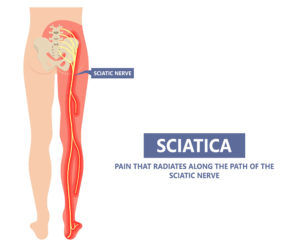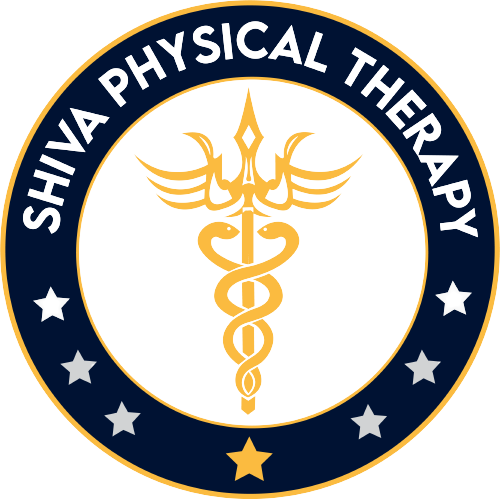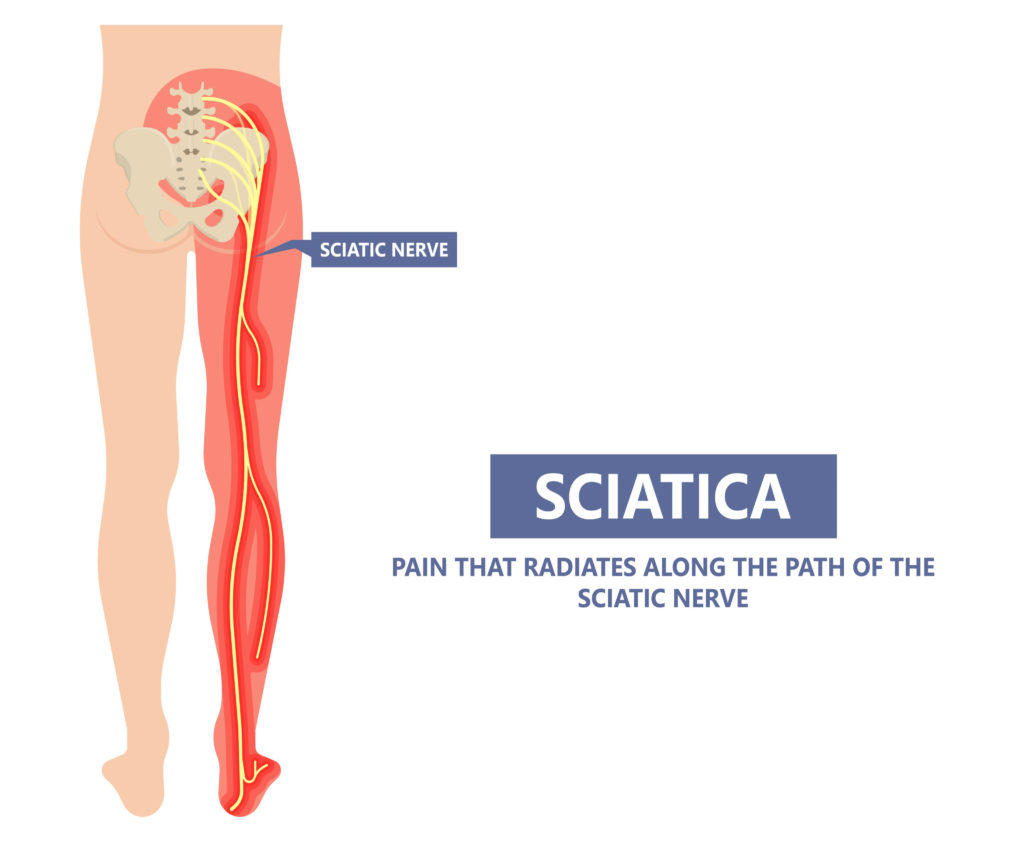
The first question I get from a patient who suffers from Sciatica is, what is the best treatment for Sciatica? In this article, let’s go in-depth and review about options available.
Sciatica pain is the term for nerve pain along the course of the sciatic nerve; this is caused due to irritation or nerve root pathology and is a debilitating condition. The sciatic nerve is made up of the L4 through S2 nerve roots that merge to form the sciatic nerve, the largest nerve in the human body. There is no gender predominance in Sciatica, and peak incidence occurs in patients in their fourth decade with lifetime incidence between 10%-40% and rarely occurs before the age of 20 unless secondary to trauma. Typically, Sciatica affects one side of the body.
Sciatica symptoms:
Affected patients experience pain and/or paresthesia usually radiates into the buttock, hip, and down the back of the leg to the foot, which is the classic sign of Sciatica. This pain often is associated with sharp, tingling, numbness, or weakness of the affected side. Sciatic pain can vary widely from mild to severe, with pain in one leg part and numbness in another region. Sometimes it feels like an electric shock and can get worse when coughing or sneezing. Prolonged sitting and standing can aggravate the symptoms, usually on one side of the affected body.
Causes of Sciatica:
Sciatica occurs when there is pathology along the course of the sciatic nerve. The pathology can be any of the following conditions listed below:
- Lumbar disc herniation
- Muscle spasm and /or Inflammation of back and /or pelvic muscles.
- Nerve root impingement/pinch
- Piriformis syndrome -results in Sciatica-like pain.
- Spondylolisthesis
- Tumors, in some cases
- Epidural abscess
- Epidural Hematoma
Nearly 85% of the time, Sciatica pain is associated with a disk disorder of the lumbosacral region. Sciatica pain occurs differently for everyone. Different nerve roots may be affected in Sciatica, each causing pain and/or numbness in another part of the thigh, Best.
Best Treatment for Sciatica:
Recovering from sciatic pain seems near impossible when it first strikes and when pain is at its most acute stage. Sciatic nerve pain often goes away without any treatment intervention and/ or with rest when you have it for the first time. According to the latest research cited by the National Institutes of Health, Sciatic pain relief often arrives in four to six weeks without advanced treatment. If the pain persists for a more extended period, an advanced treatment option should be chosen based on your doctors’ recommendations. The response to a specific treatment may vary between different patients with the same diagnosis for Sciatica. Finding the proper treatment is usually a process as patients go to various providers for relief from the pain. As each provider will be treating the same pain differently, you mustn’t make rushed decisions or undergo extensive medical treatment procedures until a proper diagnosis of Sciatica is obtained. No single treatment will help you recover from sciatic pain, like a single best sciatica Treatment or a Best sciatic pain treatment.
There is a host of alternative and conservative treatment options for treating Sciatica. In this article, we will be exploring Physical therapy treatment options. In my current practice, the following treatment seems to give excellent results with Sciatic pain in general, as no single treatment works for everyone.
Spinal Manipulation therapy has been a treatment for back pain and Sciatica for centuries. Recent research shows spinal manipulation treatment has short-term benefits for the patient with Sciatica. Not all patients will benefit from spinal manipulation therapy. The therapist will make a careful, comprehensive assessment and see if the spinal Manipulation will give you the best treatment outcomes and proceed with the treatment. During spinal Manipulation, the therapist uses their hands to apply a controlled thrust to a joint of your spine. The amount of force can vary, but the thrust moves the joint more than it would on its own. Spinal Manipulation frees restricted spine movement, improves flexibility, and helps restore proper position in the spinal column. Spinal adjustment helps reduce nerve irritability responsible for Inflammation, muscle spasm, pain, and other symptoms related to Sciatica. Adjustments should not be painful when performed, and the therapist practices different techniques to manipulate the same joints.
Spinal Decompression Therapy or nonsurgical decompression involves stretching and decompressing the spine using mechanical or manual devices. These devices work by causing traction of the vertebra and creating the decongestion at the intervertebral disc by creating a negative intradiscal pressure to heal or reposition the herniated or bulged disc to relieve the pain and promote a healing environment for the bulged, degenerated, and or herniated disc by increasing the influx of healing nutrients. While the fundamental theory of spinal decompression is widely accepted as valid, some potential risks should not be attempted with proper training.
Manual therapy for Sciatica is a valuable treatment technique if performed by a well-trained Physical therapist after a comprehensive physical examination. Manual therapy techniques commonly include kneading and Manipulation of muscles, joint mobilization, and joint Manipulation. Different types of Manual therapy techniques can be utilized when treating Sciatic pain, and a few of them are listed below with their basic information.
- McKenzie therapy is a standardized approach to assessing and treating sciatica pain. This therapeutic approach requires a patient to move through a series of activities and test movements to measure the patient’s pain. The therapist then uses the information to develop an exercise protocol to centralize or alleviate the pain. While the McKenzie method successfully treats sciatic pain, it is also helpful for the patient to continue after their recovery from sciatic pain.
- Mulligan Mobilization has been developed to overcome joint tracking problems or positional faults to reduce pain and improve the patient’s range of motion. When applying Mulligan therapy techniques, the physical therapist will identify comparable signs, including loss of joint movement in the spine, pain associated with exercise, or pain related to specific functional activities. Then a passive accessory joint mobilization is applied to the spine. Using various combinations, the therapist will try to find the correct treatment plane and grade of movement. When done, the equal sign should be significantly improved by either increasing the range of motion or decreasing pain. If done correctly, this should give immediate pain relief to the patient.
- Muscle energy technique (MET) MET is a form of manual or ‘hands-on’ therapy used by physical therapists and other health care practitioners. In this type of therapy, a patient contracts muscles by pushing against resistance from the therapist. The goal is to help restore normal muscle and joint function and mobility. Treating patients with MET can decrease biomechanical dysfunctions and muscle soreness.
- Myofascial release therapy, Facial Manipulation, Neuro-muscular reeducation, Massage therapy, Dry needling, and cupping are a few other Manual therapies and /or Manipulation techniques that help in relaxing the muscles, decrease muscle pain and provide relief from Sciatic pain. The best treatment for sciatic pain is the combination of treatments and the therapist’s knowledge in using the techniques and knowing what to do, how to do it, and when to do it to help you recover from sciatic pain.
Physical Modalities, there are a lot of different Physical agents and modalities used in Physical therapy practice to help you get some relief and heal Sciatica if used appropriately. The following are a list of a few innovative, evidence-based, Non-Invasive treatment options available to give the best outcome for back pain and Sciatica with no downtime, risk, or side effects and faster and easier healing from Sciatic pain.
- Class IV Laser Therapy
- INDIBA
- Shockwave Therapy
- Electro Dry Needling
- SCENAR
- AlfaStim
- Stimpod 460
When trained therapist perform some of the above Modalities and treatments, when necessary, will yield great outcomes and relief from sciatic pain.
Exercise when combined with above treatment will give great results with Sciatica pain and yes, exercise is like a medicine in some ways. Exercises should be prescribed in a specific dose and formulate with each individual patient based on their diagnosis, physical assessment and need. In recent years, a lot of attention was given to exercises that focus on strengthening the core muscles in a bid to stop back pain and Sciatica. Recent evidence suggested that it’s a myth, that core strengthening does not help back pain and Sciatica as well as we thought. Unfortunately, this information hasn’t percolated through the media as quickly this time. Strengthening exercises are very important in helping with Sciatic pain and just doing exercises will not fix your sciatica pain.
There are so many conservative treatments not listed in this article that can help you with Sciatic pain and you choosing wisely to find a therapy program that meets your needs is important. Talk to your Therapist and Doctor and see if any of the above treatment will be helpful for you to be pain free from Sciatica.
Dr.Siva Parnam ,DPT, Osteopractor
Shiva Physical Therapy .



After about 2 weeks my sciatica pain is better after a few excercises i think…
But suddenly at the back of my upper legs thrre us a funny numbness fealing and it fesls.luke my knees wont do the job when waking.I fell 2x…This worry me because i sm 67 years and had 12 yesrs bsck the L5_ S1 operation..
The last x_ rsy shows L4 is nit already bad…